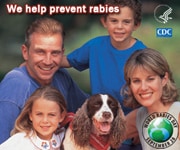Animals and Rabies

What animals get rabies?
Rabies affects only mammals. Mammals are warm-blooded animals with fur. People are also mammals. Birds, snakes, and fish are not mammals, so they can’t get rabies and they can’t give it to you. But any mammal can get rabies, including people. While rabies is rare in people in the United States, with only 1 to 3 cases reported annually, about 60,000 Americans get post-exposure prophylaxis (PEP) each year to prevent rabies infection after being bitten or scratched by an infected or suspected infected animal.
In the United States, more than 90% of reported cases of rabies in animals occur in wildlife. The wild animals that most commonly carry rabies in the United States are raccoons, skunks, bats, and foxes. Contact with infected bats is the leading cause of human rabies deaths in this country; at least 7 out of 10 Americans who die from rabies in the US were infected by bats. People may not recognize a bat scratch or bite, which can be very small, but these types of contact can still spread rabies.
Pets (like cats and dogs) and livestock (like cattle and horses) can also get rabies. Nearly all the pets and livestock that get rabies had not received vaccination or were not up to date on rabies vaccination. Most pets get rabies from having contact with wildlife.
Because of laws requiring dogs to be vaccinated for rabies in the United States, dogs make up only about 1% of rabid animals reported each year in this country. However, dog rabies remains common in many countries. Exposure to rabid dogs is still the cause of nearly all human rabies deaths worldwide. Exposure to rabid dogs outside the US is the second leading cause of rabies deaths in Americans.
How can you tell if an animal has rabies?
You can’t tell if an animal has rabies by just looking at it—the only way to know for sure if an animal (or a person) has rabies is to perform laboratory testing. However, animals with rabies may act strangely. Some may be aggressive and try to bite you or other animals, or they may drool more than normal. (This is sometimes shown in movies as animals “foaming at the mouth.”) But not all animals with rabies will be aggressive or drooling. Other animals may act timid or shy, move slowly or act tame, or let you get close to them. Because that’s not the way wild animals usually act, you should remember that something could be wrong. Some animals may not appear ill. For the health and safety of wildlife, your pets, and yourself, leave wild animals alone, including baby animals.
The best thing to do is to never feed or approach a wild animal. Be careful of pets that you do not know. If you see a stray dog or cat, don’t pet it. This is especially important if you are traveling in a country where rabies in dogs is common. And if any animal is acting strangely, call your local animal control officer for help. Some things to look for are:
- general sickness
- problems swallowing
- excessive drool or saliva
- an animal that is overly aggressive
- an animal that bites at imaginary objects (sometimes called “fly biting”)
- an animal that appears tamer than you would expect
- an animal that’s having trouble moving or may even be paralyzed
- a bat that is on the ground
How can you prevent rabies in animals?
There are several things you can do to protect your pet from rabies. These include making sure your pets get regular rabies vaccines, keeping pets away from wild animals, spaying or neutering pets, and calling animal control to remove stray animals from your neighborhood. Many states also are vaccinating wild animals (mainly raccoons) to prevent the spread of rabies. Instead of trying to catch every animal and give it a shot, they use a vaccine in a special type of food that works when the animal eats it. The food is put out where animals are likely to find it. Sometimes airplanes and helicopters are used to get the food into places that are hard to reach on foot or with a truck.
When should you see a doctor?
If you’ve been in direct physical contact with any wildlife or unfamiliar animals, particularly if you’ve been bitten or scratched, you should talk with a healthcare or public health professional to determine your risk for rabies or other illnesses. One important factor in deciding if you should receive rabies vaccination (post exposure prophylaxis) will be if the animal you were exposed to can be found and tested for rabies or held for observation. If you need rabies vaccination, it should be started soon after exposure; so talk to a healthcare provider right away to determine if you need it.

